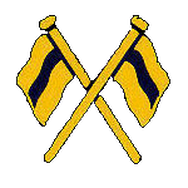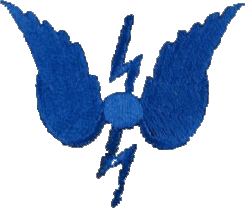


The Short History of the Telegraphby Ken Sutton
An optical telegraph is a line of stations, typically towers, for the purpose of conveying textual information by means of visual signals. There were two main types of such systems; the shutter telegraph which uses panels that can be rotated to block or pass the light from the sky behind to convey information and its successor, the semaphore telegraph which uses pivoted indicator arms and conveys information according to the direction the indicators point.
The most widely used system was the Chappe telegraph which was as shutter telegraph, and was invented in France in 1792 by Claude Chappe. It was popular in the late eighteenth to early nineteenth centuries. Chappe used the term "telegraphe" to describe the mechanism he had invented – that is the origin of the English word "telegraph". Lines of relay towers were built within line of sight of each other, at separations of 5–20 miles. Operators at each tower would watch the neighbouring tower through a telescope, and when the "shutters" began to move spelling out a message, they would pass the message on to the next tower. This system was much faster than post riders for conveying a message over long distances, and also had cheaper long-term operating costs, once constructed.
Optical telegraphy dates from ancient times, in the form of hydraulic telegraphs, torches (as used by ancient cultures since the discovery of fire) and smoke signals. Modern design of semaphores was first foreseen by the British polymath Robert Hooke, who gave a vivid and comprehensive outline of visual telegraphy to the Royal Society in a 1684 submission in which he outlined many practical details. However, the system (which was motivated by military concerns, following the Battle of Vienna in 1683) was never put into practice. The image on the left is an illustration showing Robert Hooke's proposed system. At top are various symbols that might be used; ABCE indicates the frame, and D the screen behind which each of the symbols are hidden when not in use.

Sir Richard Lovell Edgeworth's proposed system
One of the first experiments of optical signalling was carried out by the Anglo-Irish landowner and inventor, Sir Richard Lovell Edgeworth in 1767. He placed a bet with his friend, the horse racing gambler Lord March, that he could transmit knowledge of the outcome of the race in just one hour. Using a network of signalling sections erected on high ground, the signal would be observed from one station to the next by means of a telescope. The signal itself consisted of a large pointer that could be placed into eight possible positions in 45 degree increments. A series of two such signals gave a total 64 code elements and a third signal took it up to 512. He returned to his idea in 1795, after hearing of Chappe's system.
However the credit for the first successful optical telegraph goes to the French engineer Claude Chappe and his brothers in 1792, who succeeded in covering France with a network of 556 stations stretching a total distance of 4,800 kilometres (3,000 mi). Le système Chappe was used for military and national communications until the 1850s.
The French optical system remained in use for many years after other countries had switched to the electrical telegraph. Partly, this was due to inertia; France had the most extensive optical system and hence the most difficult to replace. But there were also arguments put forward for the superiority of the optical system. One of these was that the optical system is not so vulnerable to saboteurs as an electrical system with many miles of unguarded wire. Samuel Morse failed to sell the electrical telegraph to the French government. Eventually the advantages of the electrical telegraph of improved privacy, and all-weather and nighttime operation won out. A decision was made in 1846 to replace the optical telegraph with the Foy–Breguet electrical telegraph after a successful trial on the Rouen line. This system had a display which mimicked the look of the Chappe telegraph indicators to make it familiar to telegraph operators.
In 1795, the Rev. Mr Gamble proposed to the British Admiralty two distinct five-element systems: one using five shutters, and one using five ten-foot poles. However, in the same year, Lord George Murray, stimulated by reports of the Chappe semaphore, also proposed a system of visual telegraphy to the British Admiralty. He employed rectangular framework towers with six five-foot-high octagonal shutters on horizontal axes that flipped between horizontal and vertical positions to signal.
The British Admiralty accepted Murray's system in September 1795, and the first system was the 15 site chain from London to Deal. Messages passed from London to Deal in about sixty seconds, and sixty-five sites were in use by 1808.
Chains of Murray's shutter telegraph stations were built along the following routes: London to Deal and Sheerness, London to Great Yarmouth, and London to Portsmouth and Plymouth. The line to Plymouth was not completed until 4 July 1806, and so could not be used to relay the news of Trafalgar.

